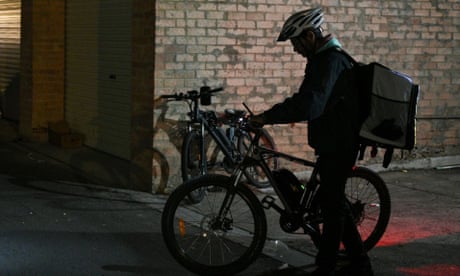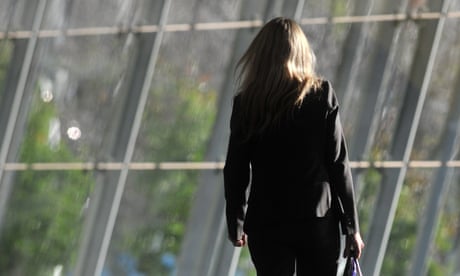Report into the gig economy finds women are earning 37% less than men
Men earn $2.67 per hour more than women on average, but 40% of workers don’t know hourly rate

Women in the gig economy are more likely to participate in historically feminised work such as clerical, sales and marketing support and care work. Photograph: andresr/Getty Images
Benita Kolovos
Benita Kolovos
Sun 27 Mar 2022
A new report commissioned by the Victorian government has found gender inequality is entrenched in the gig economy, with women earning up to 37% less than men.
The report, produced by a Queensland University of Technology research team and released on Monday, summarises Australian and global studies and found the gig economy can “both reproduce and exacerbate existing gender inequalities in work”.
According to the report, women in gig economy roles in Australia earn between 10% and 37% less than men.

NSW coroner considers inquest into deaths of four food delivery riders in road accidents
For the same work, men earned on average $2.67 per hour more than women, though about 40% of gig economy workers do not know what their hourly rate is.
Women were also significantly more likely to earn less than $40,000 annually off-platform. They are more likely to be homemakers or unpaid carers – or, if employed, to be in work that is part-time, casual, or on a fixed-term contract.
Men in the gig economy are more likely to work in software development and technology, transport and food delivery and skilled trade, while women are more likely to participate in historically feminised work such as clerical and data entry, sales and marketing support, writing and translation and care work.
According to the report, 14% of women nominated the location of their platform work as being “in the home of an individual client”, compared to 5% of men.
Melbourne woman Lorna Berry said she took up ride-share driving in 2016 to supplement her income.
But Berry is the first to admit there are challenges unique to female drivers.
“You sometimes get your ‘Boomer man’, they’ll be the ones trying to tell you how to drive or which way to go. You get asked asked a lot, ‘Do you feel safe? Where’s your partner, what’s he’s doing?’ It’s none of your business,” she said.
Advertisement
“I’ve had people criticise my driving – but then on the other hand some are really surprised I’m a good driver, it’s kind of a backhanded compliment.”
Women are also more at risk of psychical and sexual assault and exposure to illegal activity.

Gender pay gap narrows but Australian men still twice as likely as women to earn more than $120,000 a year
Berry recalled a man who insisted she drive the back streets of Eltham, north-east of Melbourne, late at night. She drove with a can of deodorant between her legs ready to use.
Another man claimed to be a police officer and repeatedly asked her if she had heard about a taxi driver that had recently been stabbed by a passenger and if she was scared.
“That was pretty unnerving. I reported him to Uber and I just got a generic response back that he had been spoken to and that I won’t be matched with him again. I still don’t know what amounted of it,” Berry said.
The Victorian government established an inquiry into the on-demand workforce in 2018 and has accepted all 20 recommendations either fully or in principle, including developing standards on fair conditions and pay.
“The gig economy can be a winner for workers, but for too many people – including many women – platform work can fail them on the test of fairness. We’re working to improve conditions in Victoria,” industrial relations minister Tim Pallas said.
A new report commissioned by the Victorian government has found gender inequality is entrenched in the gig economy, with women earning up to 37% less than men.
The report, produced by a Queensland University of Technology research team and released on Monday, summarises Australian and global studies and found the gig economy can “both reproduce and exacerbate existing gender inequalities in work”.
According to the report, women in gig economy roles in Australia earn between 10% and 37% less than men.

NSW coroner considers inquest into deaths of four food delivery riders in road accidents
For the same work, men earned on average $2.67 per hour more than women, though about 40% of gig economy workers do not know what their hourly rate is.
Women were also significantly more likely to earn less than $40,000 annually off-platform. They are more likely to be homemakers or unpaid carers – or, if employed, to be in work that is part-time, casual, or on a fixed-term contract.
Men in the gig economy are more likely to work in software development and technology, transport and food delivery and skilled trade, while women are more likely to participate in historically feminised work such as clerical and data entry, sales and marketing support, writing and translation and care work.
According to the report, 14% of women nominated the location of their platform work as being “in the home of an individual client”, compared to 5% of men.
Melbourne woman Lorna Berry said she took up ride-share driving in 2016 to supplement her income.
But Berry is the first to admit there are challenges unique to female drivers.
“You sometimes get your ‘Boomer man’, they’ll be the ones trying to tell you how to drive or which way to go. You get asked asked a lot, ‘Do you feel safe? Where’s your partner, what’s he’s doing?’ It’s none of your business,” she said.
Advertisement
“I’ve had people criticise my driving – but then on the other hand some are really surprised I’m a good driver, it’s kind of a backhanded compliment.”
Women are also more at risk of psychical and sexual assault and exposure to illegal activity.

Gender pay gap narrows but Australian men still twice as likely as women to earn more than $120,000 a year
Berry recalled a man who insisted she drive the back streets of Eltham, north-east of Melbourne, late at night. She drove with a can of deodorant between her legs ready to use.
Another man claimed to be a police officer and repeatedly asked her if she had heard about a taxi driver that had recently been stabbed by a passenger and if she was scared.
“That was pretty unnerving. I reported him to Uber and I just got a generic response back that he had been spoken to and that I won’t be matched with him again. I still don’t know what amounted of it,” Berry said.
The Victorian government established an inquiry into the on-demand workforce in 2018 and has accepted all 20 recommendations either fully or in principle, including developing standards on fair conditions and pay.
“The gig economy can be a winner for workers, but for too many people – including many women – platform work can fail them on the test of fairness. We’re working to improve conditions in Victoria,” industrial relations minister Tim Pallas said.

No comments:
Post a Comment